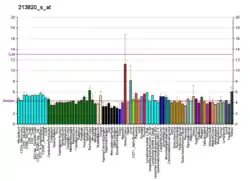| STARD5 | |||||||||||||||||||||||||||||||||||||||||||||||||||
|---|---|---|---|---|---|---|---|---|---|---|---|---|---|---|---|---|---|---|---|---|---|---|---|---|---|---|---|---|---|---|---|---|---|---|---|---|---|---|---|---|---|---|---|---|---|---|---|---|---|---|---|
| |||||||||||||||||||||||||||||||||||||||||||||||||||
| Identifiers | |||||||||||||||||||||||||||||||||||||||||||||||||||
| Aliases | STARD5, StAR related lipid transfer domain containing 5 | ||||||||||||||||||||||||||||||||||||||||||||||||||
| External IDs | OMIM: 607050 MGI: 2156765 HomoloGene: 11346 GeneCards: STARD5 | ||||||||||||||||||||||||||||||||||||||||||||||||||
| |||||||||||||||||||||||||||||||||||||||||||||||||||
| |||||||||||||||||||||||||||||||||||||||||||||||||||
| |||||||||||||||||||||||||||||||||||||||||||||||||||
| |||||||||||||||||||||||||||||||||||||||||||||||||||
| |||||||||||||||||||||||||||||||||||||||||||||||||||
| Wikidata | |||||||||||||||||||||||||||||||||||||||||||||||||||
| |||||||||||||||||||||||||||||||||||||||||||||||||||
StAR-related lipid transfer protein 5 is a protein that in humans is encoded by the STARD5 gene.[5][6] The protein is a 213 amino acids long, consisting almost entirely of a StAR-related transfer (START) domain. It is also part of the StarD4 subfamily of START domain proteins, sharing 34% sequence identity with STARD4.
Function
The protein is most prevalent in the kidney and the liver where it is found in Kupffer cells.[5][7] STARD5 binds both cholesterol and 25-hydroxycholesterol and appears to function to redistribute cholesterol to the endoplasmic reticulum with which the protein associates and/or the plasma membrane.[5][8][9] Increased levels of StarD5 increase free cholesterol in the cell.[8]
Cholesterol homeostasis is regulated, at least in part, by sterol regulatory element (SRE)-binding proteins (e.g., SREBP1) and by liver X receptors (e.g., LXRA). Upon sterol depletion, LXRs are inactive and SREBPs are cleaved, after which they bind promoter SREs and activate genes involved in cholesterol biosynthesis and uptake. Sterol transport is mediated by vesicles or by soluble protein carriers, such as steroidogenic acute regulatory protein (STAR). STAR is homologous to a family of proteins containing a 200- to 210-amino acid STAR-related lipid transfer (START) domain, including STARD5.[5][6]
References
- 1 2 3 GRCh38: Ensembl release 89: ENSG00000172345 - Ensembl, May 2017
- 1 2 3 GRCm38: Ensembl release 89: ENSMUSG00000046027 - Ensembl, May 2017
- ↑ "Human PubMed Reference:". National Center for Biotechnology Information, U.S. National Library of Medicine.
- ↑ "Mouse PubMed Reference:". National Center for Biotechnology Information, U.S. National Library of Medicine.
- 1 2 3 4 Soccio RE, Adams RM, Romanowski MJ, Sehayek E, Burley SK, Breslow JL (May 2002). "The cholesterol-regulated StarD4 gene encodes a StAR-related lipid transfer protein with two closely related homologues, StarD5 and StarD6". Proceedings of the National Academy of Sciences of the United States of America. 99 (10): 6943–8. Bibcode:2002PNAS...99.6943S. doi:10.1073/pnas.052143799. PMC 124508. PMID 12011452.
- 1 2 "Entrez Gene: STARD5 START domain containing 5".
- ↑ Rodriguez-Agudo D, Ren S, Hylemon PB, Montañez R, Redford K, Natarajan R, Medina MA, Gil G, Pandak WM (June 2006). "Localization of StarD5 cholesterol binding protein". Journal of Lipid Research. 47 (6): 1168–75. doi:10.1194/jlr.M500447-JLR200. PMID 16534142.
- 1 2 Rodriguez-Agudo D, Ren S, Hylemon PB, Redford K, Natarajan R, Del Castillo A, Gil G, Pandak WM (August 2005). "Human StarD5, a cytosolic StAR-related lipid binding protein". Journal of Lipid Research. 46 (8): 1615–23. doi:10.1194/jlr.M400501-JLR200. PMID 15897605.
- ↑ Chen YC, Meier RK, Zheng S, Khundmiri SJ, Tseng MT, Lederer ED, Epstein PN, Clark BJ (August 2009). "Steroidogenic acute regulatory-related lipid transfer domain protein 5 localization and regulation in renal tubules". American Journal of Physiology. Renal Physiology. 297 (2): F380-8. doi:10.1152/ajprenal.90433.2008. PMC 2724253. PMID 19474188.
Further reading
- Strauss JF, Kishida T, Christenson LK, Fujimoto T, Hiroi H (April 2003). "START domain proteins and the intracellular trafficking of cholesterol in steroidogenic cells". Molecular and Cellular Endocrinology. 202 (1–2): 59–65. doi:10.1016/S0303-7207(03)00063-7. PMID 12770731. S2CID 7301974.
- Maruyama K, Sugano S (January 1994). "Oligo-capping: a simple method to replace the cap structure of eukaryotic mRNAs with oligoribonucleotides". Gene. 138 (1–2): 171–4. doi:10.1016/0378-1119(94)90802-8. PMID 8125298.
- Suzuki Y, Yoshitomo-Nakagawa K, Maruyama K, Suyama A, Sugano S (October 1997). "Construction and characterization of a full length-enriched and a 5'-end-enriched cDNA library". Gene. 200 (1–2): 149–56. doi:10.1016/S0378-1119(97)00411-3. PMID 9373149.
- Wines ME, Lee L, Katari MS, Zhang L, DeRossi C, Shi Y, Perkins S, Feldman M, McCombie WR, Holdener BC (February 2001). "Identification of mesoderm development (mesd) candidate genes by comparative mapping and genome sequence analysis". Genomics. 72 (1): 88–98. doi:10.1006/geno.2000.6466. PMID 11247670.
- Soccio RE, Adams RM, Maxwell KN, Breslow JL (May 2005). "Differential gene regulation of StarD4 and StarD5 cholesterol transfer proteins. Activation of StarD4 by sterol regulatory element-binding protein-2 and StarD5 by endoplasmic reticulum stress". The Journal of Biological Chemistry. 280 (19): 19410–8. doi:10.1074/jbc.M501778200. PMID 15760897.
- Rodriguez-Agudo D, Ren S, Hylemon PB, Redford K, Natarajan R, Del Castillo A, Gil G, Pandak WM (August 2005). "Human StarD5, a cytosolic StAR-related lipid binding protein". Journal of Lipid Research. 46 (8): 1615–23. doi:10.1194/jlr.M400501-JLR200. PMID 15897605.
- Rodriguez-Agudo D, Ren S, Hylemon PB, Montañez R, Redford K, Natarajan R, Medina MA, Gil G, Pandak WM (June 2006). "Localization of StarD5 cholesterol binding protein". Journal of Lipid Research. 47 (6): 1168–75. doi:10.1194/jlr.M500447-JLR200. PMID 16534142.




